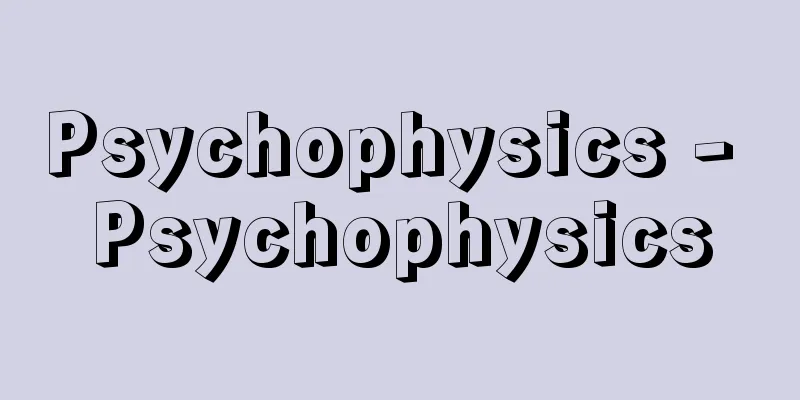Psychophysics - Psychophysics

|
Psychophysics is a branch of psychology that quantitatively measures sensations and perceptions and examines the quantitative relationship between stimuli and sensations and perceptions. It was founded by GT Fechner in the 19th century. [What is psychophysics?] The Japanese name for the English word "psychophysics" is either "spiritual physics" or "psychophysics." The name "psychophysics" is often used to refer to the science proposed by Fechner, as described below, or to the measurement methods derived from Fechner (adjustment method, limit method, constant method). Nowadays, the term "psychophysics" is generally used to refer to research methods that measure sensations and perceptions after controlling stimuli, and to the approach to research subjects that uses these research methods. [The origin of psychophysics and Fechner's law] Fechner published "Elemente der Psychophysik" in 1860, in which he positioned psychophysics as an exact science of the relationship between the body and the mind. Aiming to quantitatively clarify the relationship between the physical world and the mental (psychological) world, he explored the quantitative laws that hold between the characteristics of stimuli belonging to the "physical" world and the intensity of sensations belonging to the "mental" world. Fechner further distinguished between external psychophysics and internal psychophysics based on the difference in the objects he dealt with. External psychophysics deals with the indirect relationship between stimuli that can be observed from the outside and sensory judgments, while internal psychophysics deals with the more direct relationship between physiological activity inside the living body and sensations that are difficult to observe from the outside. Fechner placed more importance on internal psychophysics, but due to technical limitations of the research at the time, he was unable to actually examine it, so he continued to research external psychophysics. In it, he systematized methods for measuring sensations, proposing the mean error method, the just noticeable difference method, and the right or wrong method. These methods correspond to the current adjustment method, method of limits, and method of constancy, respectively, and are often collectively referred to as psychophysical methods. In clarifying the quantitative relationship between stimulus intensity and the magnitude of sensation, Fechner did not directly measure the magnitude of sensation. This was because he believed that the magnitude of sensation itself could not be measured. For example, when there are two stimuli, we can compare the sensation to them and judge that one is larger, smaller, or equal, but when one is larger, we cannot judge how much larger it is. For this reason, in the psychophysical measurement method systemized by Fechner, the stimulus value that produces a specific sensation (meets a specific criterion), such as the stimulus intensity at which the presence of a certain stimulus can be just detected (absolute threshold) or the difference in stimulus intensity at which the difference between two stimuli can just be detected (discrimination threshold), is measured, but the magnitude of sensation itself is not measured. While Fechner took the position that it is not possible to make a quantitative judgment regarding the magnitude of a sensation, he attempted to specify the quantitative relationship between the intensity of a stimulus and the magnitude of a sensation by expressing the magnitude of a sensation using the discrimination threshold as a unit. First, the lower limit at which a sensation occurs can be specified by the absolute threshold. When the stimulus is strengthened from the intensity of the stimulus corresponding to the absolute threshold, the amount of sensation also increases, but the amount by which the amount of stimulus change produces a change in the amount of sensation can be determined by the discrimination threshold. Then, assuming that the change in the amount of sensation corresponding to the discrimination threshold is always the same, the amount of sensation in response to a certain stimulus can be expressed as the intensity of that stimulus increased by a number of discrimination thresholds starting from the absolute threshold. To use this method, it is necessary to determine how the discrimination threshold changes depending on the stimulus intensity, and this point has already been formulated by Weber, EH, as follows: If we fix the intensity of one of the two stimuli at a value I and measure the discrimination threshold ( ΔI ) by adjusting the intensity of the other, then: ΔI/I=k or ΔI=k・I ( k is a constant) The following relationship holds. The discrimination threshold changes depending on the intensity of the stimulus being compared, but the ratio to the stimulus intensity remains constant. Fechner named this Weber's law. According to this law, if an increase of 1 g is required to detect a difference from a weight of 50 g, then an increase of 2 g is required for 100 g. The ratio of stimulus intensity to discrimination threshold is called the Weber ratio. Weber's law is known to hold for all senses, including vision, hearing, touch, taste, and smell, so it is also possible to compare the sensitivity of sensory modalities by comparing Weber ratios. However, Weber's law does not always hold; for example, it does not apply to intensities near the absolute threshold. Based on Weber's law and the aforementioned assumption that the change in the amount of sensation corresponding to the discrimination threshold is constant, Fechner derived the following function, which represents the relationship between the amount of stimulus ( I ) and the amount of sensation ( S ): S = c log I (c is a constant) A function that shows the correspondence between the amount of stimulus and the amount of sensation is called a psychophysical law, and the one derived by Fechner is called Fechner's law. This law, which states that the amount of sensation is proportional to the logarithm of the amount of stimulus, indicates that in order to change the amount of sensation arithmetically, the amount of stimulus must be changed geometrically. It should be noted that while Weber's law is a law that shows the relationship between the amount of stimulus ( ΔI ) and the amount of stimulus ( I ), Fechner's law is a law that shows the relationship between the amount of stimulus and the amount of sensation, and the two are essentially different. Thus, Fechner established a psychophysical law, but if Fechner's law is correct, the relationship between the amount of stimulus and the amount of sensation is expressed by the same negatively accelerated logarithmic function, regardless of the difference in sensory modality or the difference in sensory attributes within the same modality. In addition, doubts and counterarguments have been raised about the validity of the assumption made when deriving this law that the change in the amount of sensation corresponding to the discrimination threshold is always the same, and there has also been criticism of the appropriateness of replacing the discrimination threshold and the corresponding amount of sensation with differential amounts when deriving the law. Furthermore, there are criticisms that since the conditions under which Weber's law, on which this law is based, hold true are limited, Fechner's law holds true only within that range. For this reason, Fechner's law is no longer considered to broadly express the relationship between stimuli and sensations. Although Fechner's law has some problems as described above, Fechner's achievement of introducing the procedure of measurement into the study of sensation and perception by establishing the psychophysical measurement method and thereby turning the study of sensation and perception into a natural science is unshakable. [Magnitude estimation method and Stevens' law] As mentioned above, traditional psychophysics originating from Fechner takes the position that the intensity of a sensory experience cannot be quantitatively determined, and in measurement, a method is adopted to determine the amount of stimulus that produces a specific sensation. In contrast, Stevens, SS, takes the position that the intensity of a sensory experience can be directly expressed numerically, and devised a magnitude estimation method in which the observer directly reports a number corresponding to the subjective intensity (size) of the sensation felt in response to a stimulus. This procedure can be considered a method of constructing a sensory scale directly from the numerical value reported by the observer (direct scaling method). Stevens used this method to examine the relationship between various sensory quantities ( E ), including the brightness of light and the loudness of sound, and the amount of stimulus ( I ), and found that the following relationship exists between the two. E = a In ( a is a constant) This is also one of the psychophysical laws, known as Stevens' law or Stevens' power law. n is the power exponent, which takes different values depending on the type of sensory experience and the stimulation conditions (table), and this changes the shape of the function (figure). When n = 1 , the relationship between the amount of stimulus and the amount of sensation is linear, when n > 1 it is an increasing function with positive acceleration, and when 0 < n < 1 it is an increasing function with negative acceleration. According to Stevens' law, when the amount of stimulus is multiplied by a constant ( k times), the amount of sensation also changes by a constant multiple ( k n times). The problem with direct scaling methods such as magnitude estimation is that the nature of the sensory scale obtained is unclear. It is difficult to specify whether the scale is a ratio scale, an interval scale, or an ordinal scale. In contrast, in traditional psychophysical measurement methods, the threshold and subjective equivalent point obtained as the result of the measurement are the stimulus quantity (physical quantity), so the nature of the scale is not an issue. Stevens countered the claim that it is possible to make quantitative judgments about the magnitude of sensations and the criticism about the nature of the sensory scale obtained by the magnitude estimation method with an experiment on matching different sensory quantities. If it is possible to make quantitative judgments about the magnitude of sensations in all sensory domains, it should be possible to match sensory quantities between different senses, such as the brightness of light and the loudness of sound. In other words, it should be possible to adjust the intensity of one stimulus so that the loudness of a sound stimulus and the brightness of a light stimulus are quantitatively equal. If a power law holds between the stimulus quantity and the sensory quantity in each sensory domain, the results of such matching of different sensory quantities can be predicted as follows. Now, if a power law holds between one sense (e.g., the brightness of light E 1 ) and another sense (the loudness of sound E 2 ) ( E 1 = a 1 I α 1 , E 2 = a 2 I β 2 ), and if matching of these sensory quantities is performed ( E 1 = E 2 ), the following relationship is obtained. ( k is a constant) That is, the results of cross-sensory matching would be represented by a straight line on a log-log plot, with the slope being the ratio of the exponents calculated for each sense. Stevens et al. verified this prediction, providing evidence to support their position without using any numbers. However, Stevens's argument was further criticized by subsequent research. One of these criticisms was regarding what the results obtained by the magnitude estimation method represent. Stevens thought that the results obtained by the magnitude estimation method directly indicated the relationship between the stimulus amount and the sensory amount, but criticism was raised that in fact the results were the result of cross-sensory amount matching between the sensory amount in question and the sensory amount of the number. In other words, if we consider the number as a stimulus and the magnitude of the number as the sensation of that number, the measurement using the magnitude estimation method matches the sensory amount felt for the stimulus being measured with the sensory magnitude of the number, and the corresponding number as the stimulus is reported. If this is correct, then the relationship between the stimulus amount to be measured and the sensory amount cannot be known unless the functional relationship that exists between the number as a stimulus and the sensory magnitude of the number is clarified. In addition, there is criticism that even if a functional relationship other than a power function exists between the stimulus amount and the sensory amount, a power function may apply to the results of cross-sensory amount matching. Therefore, even if a power function is obtained by the magnitude estimation method, it does not necessarily mean that a power function exists between the stimulus amount and the sensory amount. Furthermore, the answers to questions such as why a power function exists between the amount of stimulus and the amount of sensation in the first place, and what characteristics of the sensory nervous system it reflects, are still not clear. As described above, the theoretical and empirical basis for the position that the magnitude of sensations can be expressed numerically and the Stevens' law derived based on this position is not necessarily clear, and some researchers question the validity of the magnitude estimation method. However, in research that seeks to quantitatively describe sensory and perceptual characteristics, especially in applied and practical research, it is true that the magnitude estimation method is used in a variety of situations, with these issues put aside. [Descriptive psychophysics and analytical psychophysics] The establishment of psychophysical measurement methods has made it possible to quantitatively measure sensation and perception, which has greatly advanced research into sensation and perception. By repeatedly measuring within an individual, and by comparing the characteristics and functions of sensations between different individuals, it has become possible to clarify the general characteristics of sensation and perception. Furthermore, quantitative hypothesis verification experiments have become possible, and through these, it has become possible to investigate the mechanisms underlying sensation and perception. When the aim is to quantitatively describe sensory characteristics, as in the former case, this is specifically called descriptive psychophysics, and when the aim is to clarify mechanisms, as in the latter case, it is called analytical psychophysics. The purpose of descriptive psychophysics is to clarify the characteristics of sensation and perception through measurements. How small a stimulus is required to detect the presence of a stimulus (measurement of stimulus threshold), how small a stimulus difference is required to distinguish (discriminate) two stimuli (measurement of discrimination threshold), and how the sensory quantity changes with changes in the stimulus quantity (construction of sensory scale) can all be considered to belong to descriptive psychophysics. Descriptive psychophysics is not only academically significant in deepening our understanding of sensation and perception, but is also extremely valuable in applied and practical applications. For example, research into descriptive psychophysics established the trichromatic nature of color vision (all colored light can be matched by additively mixing three independent primary stimuli). This made it clear that perceived colors can be reproduced by adjusting the intensities of red, green, and blue light without reproducing the original stimuli themselves, and is used in current color televisions and other devices. In addition, the sensory and perceptual characteristics measured through descriptive psychophysics research are used in various aspects of human life, such as when developing and designing means of information transmission and communication, including telephones and road signs, and in developing lighting. Analytical psychophysics examines hypotheses about the physiological mechanisms underlying sensation and perception based on quantitative analysis of sensory and perceptual characteristics. Many current psychophysical studies aim to elucidate these mechanisms. Analytical psychophysics attempts to associate sensation and perception with physiological processes, and the hypothesis that serves as the basis for relating the two is called the psychophysical linking hypothesis. The most rigorous of these linking hypotheses is the identity hypothesis, which states that the same sensation is based on the same physiological event. According to this hypothesis, if different stimuli cause exactly the same sensation, it is assumed that the same neural activity occurs in the physiological process. Brindley, GS, called observations that only concern whether the sensation caused by two stimuli is the same or not class A observations, and all other observations class B observations. For example, as mentioned above, it is possible to adjust the appearance of colors between a light obtained by additively mixing three types of original stimuli and a certain colored light so that they appear completely equal, but such color matching experiments are class A observations. The hypothesis of trichromatism and identity of color vision revealed by color matching experiments led to the idea that when color matching is established, the same neural activity occurs for two stimuli, and subsequent research led to the identification of three types of cones. Threshold measurement experiments are also included in Class A observations, as they are thought to be concerned with whether the same sensation is generated if the sensory experience is the same when the threshold is reached for different stimuli. Thresholds are rarely an issue in everyday life, but threshold measurements are emphasized in sensory and perception research because thresholds are an effective measure when examining sensory mechanisms. Regarding the psychophysical correlation hypothesis, Müller, GE, has proposed hypotheses other than identity, such as similarity (if sensations are similar, activity in physiological processes is similar), directionality (when sensations change in a certain direction, activity in physiological processes will show a similar change), and dimensionality (if sensations show n-dimensional changes, the change in activity in physiological processes will also be n-dimensional), but the rigor of these hypotheses is subject to debate. Since psychophysics does not directly measure activity in physiological processes, it is necessary to constantly pay attention to the question of what correlation hypothesis is assumed when examining mechanisms. →Threshold →Sensation →Sensory scale →Stimulus →Psychophysical measurement method →Perception〔Kimura, Eiji〕 "> Figure Stevens' Law (Excerpt from Stevens, 1975) Table: Questions about various sensory experiences... Latest Sources Psychology Encyclopedia Latest Psychology Encyclopedia About Information |
|
感覚・知覚を定量的に測定し,刺激と感覚・知覚との間の数量的関係を検討する心理学の一分野を精神物理学,あるいは心理物理学という。19世紀にフェヒナーFechner,G.T.によって創始された。 【精神物理学とは何か】 英語名「psychophysics」の和名に関しては,「精神物理学」と「心理物理学」の両方が用いられている。「精神物理学」という名前は,後述するようにフェヒナーの提唱した学問自体を指す場合や,フェヒナーに由来する測定方法(調整法,極限法,恒常法)を指す場合などに用いられることが多い。現在では,刺激を統制したうえで感覚・知覚を測定する研究手法や,その研究手法を用いた研究対象に対するアプローチの仕方を指すために,「心理物理学」という用語を用いることが一般的になっている。 【精神物理学の起源とフェヒナーの法則】 フェヒナーは,1860年に『精神物理学要論Elemente der Psychophysik』を出版し,その中で身体と精神の関係に関する精密科学として精神物理学を位置づけた。物理世界と精神世界(心理的世界)の関係を定量的に解明することをめざし,「物理」世界に属する刺激の特性と「精神」世界に属する感覚の強さとの間に成立する数量的法則を探究した。フェヒナーは,さらに扱う対象の違いによって,外的精神物理学と内的精神物理学とを分けている。外的精神物理学は,外部から観察可能な刺激と感覚判断との間接的な関係を扱い,内的精神物理学は,外部からは観察困難な生体内部の生理的活動と感覚との間のより直接的な関係を扱う。フェヒナーは内的精神物理学の方を重視していたが,当時の研究の技術的制約により実際には検討することができず,外的精神物理学の研究を進めた。そして,その中で感覚を測定する方法を体系化し,平均誤差法,丁度可知差異法,当否法として提案した。これらの方法は,それぞれ現在の調整法,極限法,恒常法に対応しており,精神物理学的測定法psychophysical methodと総称されることが多い。 刺激強度と感覚の大きさの数量的関係を解明するに当たって,フェヒナーは感覚の大きさを直接的に測定することはしなかった。それは,彼が感覚の大きさそのものは測ることができないと考えていたためである。たとえば,二つの刺激があったときに,それらに対する感覚を比較して,一方が大きい,小さい,あるいは等しいという判断はできるが,一方が大きいときに,それがどれだけ大きいのかを判断することはできないと考えていたのである。このため,フェヒナーが体系化した精神物理学的測定法では,ある刺激の存在がちょうど感知できる刺激強度(絶対閾)や,二つの刺激の違いがちょうどわかる刺激強度の差(弁別閾)など,特定の感覚を生じさせる(特定の基準を満たす)刺激値が測定され,感覚の大きさそのものは測定されない。 フェヒナーは,感覚の大きさに関する量的な判断はできないとする立場に立ちながら,弁別閾を単位として感覚の大きさを表わすことによって,刺激強度と感覚の大きさの数量的関係を特定しようと試みた。まず,感覚が生じる下限は絶対閾によって特定することができる。絶対閾に当たる刺激強度から刺激を強めていくと感覚量も増えるが,刺激量をどれだけ変化させると感覚量の変化が生じるかは,弁別閾によって求めることができる。そして,弁別閾に対応する感覚量の変化はつねに同じであると仮定すると,ある刺激に対する感覚量は,その刺激の強度が絶対閾を出発点として弁別閾いくつぶん増やしたものにあたるかで表わすことができる。 この方法を用いるためには,刺激強度に応じて弁別閾がどのように変化するかを特定する必要があるが,この点に関しては,すでにウェーバーWeber,E.H.によって次のように定式化されていた。今,二つの刺激の一方の強度をIという値に固定し,他方の強度を調整することで弁別閾(ΔI)を測定したとすると, ΔI/I=k あるいは ΔI=k・I (kは定数) という関係が成立する。弁別閾は比較対象となる刺激の強度によって変わるが,その刺激強度との比は一定となる。フェヒナーはこれをウェーバーの法則Weber's lawと名づけた。この法則によれば,たとえば50gの重さとの違いを検知するために1g増やす必要があったとすると,100gに対しては2g増やす必要があることになる。刺激強度と弁別閾との比率はウェーバー比Weber ratioとよばれる。ウェーバーの法則は,視覚,聴覚,触覚,味覚,嗅覚などすべての感覚で成立することが知られているため,感覚モダリティ間でウェーバー比を比較することで感度の善し悪しを比較することもできる。ただし,ウェーバーの法則はつねに成立するわけではなく,たとえば絶対閾近傍の強度では当てはまらない。 ウェーバーの法則と,弁別閾に相当する感覚量の変化分は一定であるとの前述の仮定に基づき,フェヒナーは,刺激量(I)と感覚量(S)との関係を表わす以下のような関数を導いた。 S=c・logI (cは定数) このように刺激量と感覚量の対応関係を示した関数を精神物理学的法則psychophysical lawとよび,フェヒナーにより導出されたものをフェヒナーの法則Fechner's lawという。感覚量が刺激量の対数に比例するというこの法則は,感覚量を等差的に変化させるためには,刺激量を等比的に変化させなくてはならないことを表わしている。なお,ここで注意すべきなのは,ウェーバーの法則が刺激量(ΔI)と刺激量(I)の関係を表わす法則であったのに対して,フェヒナーの法則は刺激量と感覚量との関係を表わす法則であり,両者は本質的に異なるという点である。 このように,フェヒナーによって精神物理学的法則が確立されたが,フェヒナーの法則が正しいとすると,感覚モダリティの違いや同一モダリティ内での感覚属性の違いにかかわらず,刺激量と感覚量の関係は,対数関数という負に加速された同一の関数で表わされることになる。また,この法則を導出する際に設定された,弁別閾に対応する感覚量の変化はつねに同じであるという仮定の妥当性に対して,疑問や反証が挙げられており,法則の導出に当たって弁別閾やそれに対応する感覚量を微分量で置き換えたことの是非などに対する批判もなされている。さらには,この法則の基礎となるウェーバーの法則が成立する条件が限られるため,フェヒナーの法則が成立するのもその範囲内に限られるとの批判もある。このため,現在では,フェヒナーの法則が広く刺激と感覚の関係を表わすものであるとは考えられていない。このようにフェヒナーの法則には問題点があるが,精神物理学的測定法を確立することによって感覚・知覚研究に測定という手続きを導入し,感覚・知覚研究を自然科学たらしめたフェヒナーの功績は揺るぎないものである。 【マグニチュード推定法とスティーブンスの法則】 前述のように,フェヒナーに由来する伝統的な精神物理学は,感覚経験の強さを数量的に判断できないとする立場に立ち,測定においては,特定の感覚を生じさせる刺激量を決定するという方法が採用された。これに対して,スティーブンスStevens,S.S.は,感覚経験の強さを直接的に数値で表現できるとの立場に立ち,刺激に対して主観的に感じられる感覚の強さ(大きさ)に対応する数を観察者に直接報告させるマグニチュード推定法magnitude estimationを考案した。この手続きは,観察者が報告する数値から直接的に感覚尺度を構成する方法(直接的尺度構成法)とみなせる。スティーブンスは,この方法を用いて光の明るさや音の大きさをはじめとするさまざまな感覚量(E)と刺激量(I)の関係を検討し,両者の間には,以下のような関係が成立することを見いだした。 E=a・In (aは定数) これも精神物理学的法則の一つであり,スティーブンスの法則Stevens' law,あるいはスティーブンスのベキ法則Stevens' power lawという。nはベキ指数で,感覚経験の種類,刺激条件などによって異なる値を取り(表),これによって関数の形が変わる(図)。n=1であれば,刺激量と感覚量の関係は線形となり,n>1であれば正の加速度をもつ増加関数,0<n<1であれば負の加速度をもつ増加関数となる。スティーブンスの法則によると,刺激量を定数倍(k倍)すると,感覚量も定数倍(kn倍)変化することになる マグニチュード推定法など直接的尺度構成法の問題点は,得られる感覚尺度の性質が明確でないことにある。この尺度は比尺度(比率尺度)であるのか,間隔尺度であるのか,あるいは順序尺度であるのかを特定することは困難である。これに対して伝統的な精神物理学的測定法では,測定の結果として得られる閾値や主観的等価点は刺激量(物理量)であるので,尺度の性質が問題になることはない。 感覚の大きさに関する数量的判断ができるという主張や,マグニチュード推定法により得られる感覚尺度の性質に関する批判に対して,スティーブンスは異種感覚量マッチングの実験により反論している。もし,すべての感覚領域において,感覚の大きさに関する数量的判断ができるのであれば,たとえば光の明るさと音の大きさといった異なる感覚の間で,感覚量のマッチングが可能なはずである。つまり,音刺激に対して感じる音の大きさと光刺激に対して感じる明るさとが量的に一致するように,一方の刺激強度を調節することができるはずである。そして,各感覚領域において刺激量と感覚量の間にベキ法則が成立するのであれば,こうした異種感覚量マッチングの結果を,以下のように予測できる。今,ある感覚(たとえば光の明るさE1)と別の感覚(音の大きさE2)のそれぞれに関してベキ法則が成立しており(E1=a1Iα1,E2=a2Iβ2),この感覚量のマッチングを行なったとすると(E1=E2),次の関係が得られる。 (kは定数) すなわち,異種感覚量マッチングの結果は,対数-対数プロットで示すと直線で表わされ,その傾きは,各感覚に関して求められたベキ指数の比で表わされることになる。スティーブンスらはこの予測を実証し,数をまったく使用せずに,自らの立場を支持する証拠を提供した。 しかし,スティーブンスの主張は,その後の研究によりさらに批判されることになる。その一つは,マグニチュード推定法によって得られる結果が何を表わすかに関するものである。スティーブンスは,マグニチュード推定法によって得られる結果が刺激量と感覚量の間の関係を直接的に示すものと考えていたが,実際には当該の感覚量と数の感覚量との間の異種感覚量マッチングの結果なのではないかという批判が出された。すなわち,刺激としての数とそれに対する感覚としての数の大きさを考えると,マグニチュード推定法での測定の際には,測定対象の刺激に対して感じる感覚の大きさと数の感覚的大きさとのマッチングがなされ,対応する刺激としての数が報告されているのではないかという批判である。これが正しいとすると,刺激としての数と数の感覚的大きさとの間に成立する関数関係が明らかにならない限り,測定しようとする刺激量と感覚量の関係はわからないことになる。また,刺激量と感覚量の間にベキ関数以外の関数関係が成立していたとしても,異種感覚量マッチングの結果にベキ関数が当てはまることがあるとの批判もある。したがって,マグニチュード推定法によってベキ関数が得られても,刺激量と感覚量の間にベキ関数が成り立つとは限らない。さらには,そもそも刺激量と感覚量の間になぜベキ関数が成立するのか,感覚神経系のどのような特性を反映しているのか,といった問題に対する答えも明確にはなっていない。 以上のように,感覚の大きさを数値で表現できるという立場やそれに基づいて導き出されたスティーブンスの法則に関する理論的・実証的根拠は必ずしも明確ではなく,マグニチュード推定法の妥当性を疑問視する研究者もいる。しかし,感覚・知覚特性の定量的記述を行なおうとする研究,なかでもとくに応用的・実用的研究においては,こうした問題が棚上げされた形で,さまざまな場面でマグニチュード推定法が活用されていることも確かである。 【記述的心理物理学と分析的心理物理学】 精神物理学的測定法の確立により感覚・知覚を定量的に測定できるようになったことで,感覚・知覚研究は大きく進展した。ある個人内での繰り返し測定により,また異なる個人間で感覚の特性や機能を比較検討することにより,感覚・知覚の一般的特性を明らかにすることができるようになった。さらに,定量的な仮説検証実験が可能となり,それを通じて感覚・知覚の基礎となるメカニズムを検討することが可能となった。前者のように感覚特性の定量的記述を目的とする場合,これをとくに記述的心理物理学descriptive psychophysicsとよび,後者のようにメカニズムの解明をめざす場合を分析的心理物理学analytical psychophysicsとよぶ。 記述的心理物理学では,感覚・知覚の諸特性を測定により明らかにしていくことが目的となる。どれだけ小さな刺激量で刺激の存在を検出できるのか(刺激閾の測定),どれだけ小さな刺激差があれば二つの刺激を識別(弁別)することができるのか(弁別閾の測定),刺激量の変化に伴い感覚量はどのように変化するのか(感覚尺度の構成)といった検討は,すべて記述的心理物理学に属するといえる。記述的心理物理学は,感覚・知覚に関する理解を深めるという学術的意義をもつだけでなく,応用的・実用的意義もきわめて高い。たとえば,記述的心理物理学の研究によって,色覚の三色性(あらゆる色光は,独立した3種類の原刺激を加法混色することによって等色することができる)が確立された。これにより,元の刺激自体を再現しなくても,赤,緑,青の光の強度を調整することによって知覚される色を再現できることが明らかとなり,現在のカラーテレビなどで活用されている。また,電話,道路標識などをはじめとする情報伝達やコミュニケーションのための手段を開発・設計する際や,照明の開発など,人の生活にかかわるさまざまな場面で,記述的心理物理学の研究によって測定された感覚・知覚の諸特性が活用されている。 分析的心理物理学においては,感覚・知覚特性の定量的分析に基づき,感覚・知覚の基礎となる生理学的メカニズムに関する仮説を検討する。現在の多くの心理物理学的研究は,こうしたメカニズムの解明をめざしている。分析的心理物理学では感覚・知覚と生理学的過程との対応づけが試みられるが,その際に両者を関係づける根拠となる仮説を心理物理学的連関仮説psychophysical linking hypothesisという。この連関仮説のうち最も厳密なのが,同一の感覚は同一の生理的事象に基づくという同一性の仮説である。これによれば,異なる刺激がまったく同じ感覚を引き起こしたとすると,生理学的過程においても同一の神経活動が生じていると想定される。ブリンドレイBrindley,G.S.は,二つの刺激によって生じた感覚が同じか否かのみを問題とする観察をクラスAの観察class A observationとよび,それ以外のすべての観察をクラスBの観察class B observationと名づけた。たとえば前述のように,3種類の原刺激を加法混色した光とある色光との間で,色の見えが完全に等しくなるように調整することができるが,こうした等色実験(マッチング実験)はクラスAの観察である。等色実験によって明らかとなった色覚の三色性と同一性の仮説から,等色が成立したときには二つの刺激に対して同一の神経活動が生じていると考えられ,その後の研究により3種類の錐体の特定へとつながっていった。また,閾値測定実験も,異なる刺激について閾に達したときの感覚経験が同じであれば,同一の感覚を生じさせるか否かを問題としていると考えられるので,クラスAの観察に含まれる。日常場面では閾値が問題とされることはほとんどないが,感覚・知覚研究で閾値測定が重視されるのは,このように感覚メカニズムを検討する際に閾値が有効な測度となるからである。 なお,心理物理学的連関仮説に関してミュラーMüller,G.E.は,同一性以外にも,類似性(感覚が類似していれば,生理的過程における活動も類似している),方向性(感覚がある方向へと変化した際には,生理的過程における活動も同様の変化を示す),次元性(感覚がn次元の変化を示すのであれば,生理的過程における活動の変化もn次元である)などの仮説を唱えているが,それらの仮説の厳密性については議論の対象となっている。心理物理学は生理学的過程における活動を直接測定するわけではないので,メカニズムの検討に当たっては,どのような連関仮説を前提としているのかという問題に絶えず注意を向けておく必要がある。 →閾 →感覚 →感覚尺度 →刺激 →精神物理学的測定法 →知覚 〔木村 英司〕 "> 図 スティーブンスの法則 (Stevens ,1975 より抜粋)"> 表 さまざまな感覚経験について求められ… 出典 最新 心理学事典最新 心理学事典について 情報 |
<<: Psychoanalysis - Psychoanalysis
>>: Psychopathology - Psychopathology
Recommend
Pathology - byorigaku (English spelling) pathology
Also known as the science of illness or disease, ...
primary wave
…P waves are longitudinal waves that vibrate in t...
Gymnura japonica (English spelling) Gymnura japonica
…[Toru Taniuchi]. … *Some of the terminology that...
Attack on Kishu - Kishuzeme
...The Negoro and Saika groups are also famous as...
Engi no Junkan - Engi no Junkan
…Or, old age and death exist because there is lif...
Film noir
The term "noir" comes from French and or...
Kimberley
It is a diamond mining town in the northeastern p...
Carbonate compensation depth (English spelling)
The depth in the ocean where the supply rate and d...
Blavet, Michel
Born: March 13, 1700, Besançon [Died] October 28, ...
Yellowtail amberjack - Hiramasa
A marine fish belonging to the order Perciformes ...
Isahaya Manor - Isahaya Manor
A manor located in Takaki County, Hizen Province. ...
Flower blind paper - Karenshi
… Paper that has been made as is is called “raw p...
Hadaiusu - Hadaiusu
It can also be read as "hadeusu" or &quo...
NBA (Boxing) - NBA
…Sugar Ray Robinson (USA, 1921-89), who was a fiv...
γ-Aminobutyric Acid - Gamma Amino Acid
Its chemical formula is H2NCH2CH2CH2COOH . It form...









